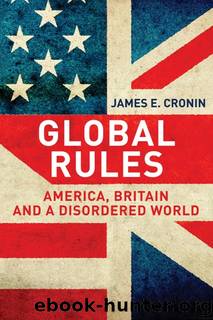Global Rules by James E. Cronin

Author:James E. Cronin
Language: eng
Format: epub
ISBN: 9780300151480
Publisher: Yale University Press
CHAPTER 8
The Shaping of the Post–Cold War World
The New Architecture and the Soviet Union
The construction of the new Europe “architecture” after the collapse of the regimes in Eastern Europe was done quickly, but great care was taken not to offend the major powers – Germany, France, Britain, the United States and, most important, the Soviet Union. Margaret Thatcher was especially worried that moving too fast on German unification would harm Gorbachev and on that she had the agreement of Bush, Mitterrand and Kohl. Soviet troops and weapons were still deployed in East Germany in 1990 even as unification was carried out, so the Germans had to be particularly careful not to provoke a reaction. These fears for the Soviet leader's future were obviously well grounded, for Gorbachev would be out of power and the Soviet Union would disappear before the end of 1991. The end of the Soviet Union did not lead to the collapse of the recently reconfigured framework of geopolitics, but it did shove it in a very particular, and very Atlantic, direction.
Gorbachev's fall and the dissolution of the state he led were the outcome of a lengthy process of decay and failed reform. The centrally planned economy never worked well. It needed mass mobilizations and terror to meet its targets and as these tools were discarded, no other mechanisms were found to replace them. Just about the only thing the Soviets did well was to build weapons, but even that came at a great cost that seemed to hold back economic development more broadly. That at least was the conclusion that Gorbachev and other Soviet leaders, and not just reformers, reached in the 1980s and it was the reason reform got as far as it did and found support even within the military. Efforts to restructure the economy, perestroika, nevertheless threatened the status and perquisites of the country's ruling elite, whose roots were in both the party and the institutions of the state. This nomenklatura, as they were called, would come to resist Gorbachev's plans for markets and private enterprise and so he decided that political reform, glasnost, was needed to overcome the resistance.1 As early as 1987, Gorbachev seems to have concluded that politics was critical and he moved first to bring the Communist Party along with him but, when that proved difficult, sought to open up the party itself. When that did not work, he attempted to escape the control of the party by grounding his rule in the institutions of the state, but to do so required that the state itself be made more responsive. At the party conference in June 1988 he proposed, therefore, to create a new and elected Congress of People's Deputies as the supreme body of the Soviet state. The elections were far from open and party members continued to dominate, but they were open enough for a number of genuine reformers to gain seats and voices. Andrei Sakharov was one and an important symbol, though Boris Yeltsin was easily the most significant.
Download
This site does not store any files on its server. We only index and link to content provided by other sites. Please contact the content providers to delete copyright contents if any and email us, we'll remove relevant links or contents immediately.
| Arms Control | Diplomacy |
| Security | Trades & Tariffs |
| Treaties | African |
| Asian | Australian & Oceanian |
| Canadian | Caribbean & Latin American |
| European | Middle Eastern |
| Russian & Former Soviet Union |
The Secret History by Donna Tartt(16623)
The Social Justice Warrior Handbook by Lisa De Pasquale(11489)
Thirteen Reasons Why by Jay Asher(7788)
This Is How You Lose Her by Junot Diaz(5772)
Weapons of Math Destruction by Cathy O'Neil(5037)
Zero to One by Peter Thiel(4824)
The Myth of the Strong Leader by Archie Brown(4789)
Promise Me, Dad by Joe Biden(4447)
Beartown by Fredrik Backman(4419)
Stone's Rules by Roger Stone(4415)
How Democracies Die by Steven Levitsky & Daniel Ziblatt(4399)
The Fire Next Time by James Baldwin(4343)
100 Deadly Skills by Clint Emerson(4079)
A Higher Loyalty: Truth, Lies, and Leadership by James Comey(4033)
Rise and Kill First by Ronen Bergman(4012)
The David Icke Guide to the Global Conspiracy (and how to end it) by David Icke(3882)
The Farm by Tom Rob Smith(3872)
Secrecy World by Jake Bernstein(3782)
The Doomsday Machine by Daniel Ellsberg(3731)
